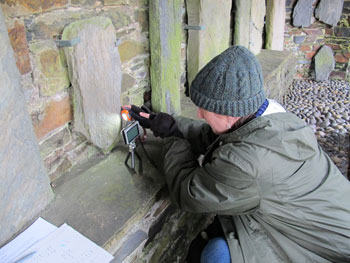
The Vikings were not just the wanton marauders of popular portrayal, says a Longwood University medieval scholar who recently conducted archaeological research on the Isle of Man.
"The exclusive image of rape, pillage and burning by the Vikings is probably inaccurate," said Dr. Larissa "Kat" Tracy, associate professor of English.
Tracy spent a week photographing inscriptions on Viking-age stone monuments on the island between Great Britain and Ireland as part of a German-based research project on the ancient runic alphabet. What she found is that the Vikings, who raided and settled throughout Europe from the late eighth century through the 11th century, were perhaps more interested in winning the hearts and minds of the people they encountered than is often thought.
"There is evidence that the Vikings integrated into the community," said Tracy, a medieval literature specialist. "There have been two assumptions about the Vikings—that they either took over Christian Celtic civilization, or that they conquered it but co-existed and assimilated. Both assumptions involve violence resistance and violent action. While most likely there was some violent action, the crosses I saw—a majority of which have depictions of legendary pre-Christian heroes—indicate a shared tradition and assimilation. As the Vikings became Christianized, they retained some non-Christian folklore and belief systems, because they were so parallel."
Tracy went to the Isle of Man at the invitation of colleague Dr. Lilla Kopár, director of Medieval and Byzantine Studies at the Catholic University of America, who needed help tracking down inscriptions on crosses and other monuments. Their work was part of the Old English and Old Frisian Runic Inscriptions database project at the Catholic University of Eichstätt-Ingolstadt in Germany, which is part of a larger project called the "Runische Schriftlichkeit in den germanischen Sprachen—Runic Writing in the Germanic languages" (RuneS) project.
"Dr. Kopár and I visited as many as six sites a day cross-checking inscriptions for the RuneS project. They had a list of stones they couldn’t find, crosses that were somewhat illegible and inscriptions that were too faint, and they wanted additional information. We know the Vikings erected crosses to commemorate loves ones, and I’m interested in how this translates into literature."
Tracy and Kopár also worked with local archaeologists, including Dr. Peter Davey of the University of Liverpool, who lives on the island and is a former director of the Centre for Manx Studies, and Allison Fox and Andy Johnson, curators of the Manx Museum.
"The Isle of Man is a treasure trove of pre-Viking, Viking and medieval archaeology," said Tracy. Her research trip was funded by the Cook-Cole College of Arts and Sciences and the Department of English and Modern Languages.
"Some of the things I saw were just amazing, such as the elaborate runic inscriptions on some of the stones. I saw Celtic grave markers and Viking-age burial sites, many located within church closures or near Christian church sites. I also saw the foundations or ruins of small chapels, which either predated or were concurrent with the Vikings.
Tracy’s trip was related to her current book project (England’s Medieval Literary Heroes: Literature, Law and National Identity), one chapter of which will examine Norse mythology in relation to Old English literary sources. "I’m interested in what heroic stories were part of Viking-era culture in the British Isles as an analysis of Beowulf," said Tracy.
Tracy also has studied, lectured and written about torture and brutality in the Middle Ages. She is the author of Torture and Brutality in Medieval Literature: Negotiations of National Identity and co-editor of Heads Will Roll: Decapitation in the Medieval and Early Modern Imagination, both published recently. Her most recent edited collection, Castration and Culture in the Middle Ages, was released in May.She co-founded and co-directs Longwood’s Undergraduate Research Conference in Medieval and Renaissance Studies.

